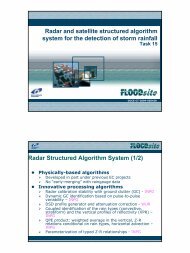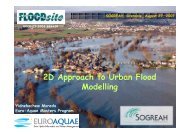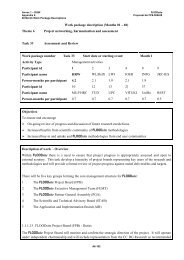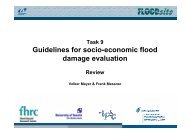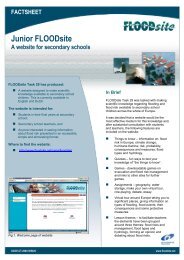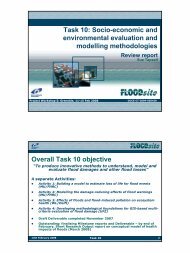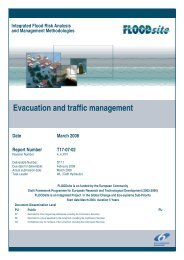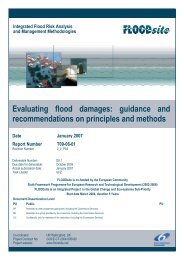Language of Risk - FLOODsite
Language of Risk - FLOODsite
Language of Risk - FLOODsite
You also want an ePaper? Increase the reach of your titles
YUMPU automatically turns print PDFs into web optimized ePapers that Google loves.
<strong>FLOODsite</strong> <strong>Language</strong> <strong>of</strong> <strong>Risk</strong> 2 nd Ed.<br />
Contract No:GOCE-CT-2004-505420<br />
Social vulnerability (Task 11)<br />
This can be defined as the characteristics <strong>of</strong> a person or group in terms <strong>of</strong> their capacity to anticipate,<br />
cope with, resist, and recover from the impact <strong>of</strong> a natural hazard. (cf vulnerability below)<br />
Spatial planning - Public policy and actions intended to influence the distribution <strong>of</strong> activities in<br />
space and the linkages between them. It will operate at EU, national and local levels and embraces<br />
land use planning and regional policy.<br />
Standard <strong>of</strong> service - The measured performance <strong>of</strong> a defined performance indicator.<br />
Strategic alternative (Task 14)<br />
A strategic alternative is a coherent set <strong>of</strong> structural and/or non-structural measures and related policy<br />
instruments for flood risk management. This should not be confused with strategies.<br />
Severity — The degree <strong>of</strong> harm caused by a given flood event.<br />
Source — The origin <strong>of</strong> a hazard (for example, heavy rainfall, strong winds, surge etc).<br />
Stakeholders — Parties/persons with a direct interest (stake) in an issue — also Stakeowners.<br />
Stakeholder Engagement - Process through which the stakeholders have power to influence the<br />
outcome <strong>of</strong> the decision. Critically, the extent and nature <strong>of</strong> the power given to the stakeholders varies<br />
between different forms <strong>of</strong> stakeholder engagement.<br />
Statistic - A measurement <strong>of</strong> a variable <strong>of</strong> interest which is subject to random variation.<br />
Strategy (flood risk management-) – A strategy is a combination <strong>of</strong> long-term goals, aims, specific<br />
targets, technical measures, policy instruments, and process which are continuously aligned with the<br />
societal context.<br />
Strategic spatial planning - Process for developing plans explicitly containing strategic intentions<br />
referring to spatial development. Strategic plans typically exist at different spatial levels (local,<br />
regional etc).<br />
Statistical inference uncertainty - See Knowledge uncertainty<br />
Statistical model uncertainty - See Knowledge uncertainty<br />
Sustainable Development - is development that meets the needs <strong>of</strong> the present without compromising<br />
the ability <strong>of</strong> future generations to meet their own needs<br />
Sustainable flood risk management provides the maximum possible social and economic resilience<br />
against flooding, by protecting and working with the environment, in a way which is fair and<br />
affordable both now and in the future.<br />
Sustainable flood risk management strategy — An approach which<br />
• aims to be effective in the long term, and<br />
• can be combined (`integrated') with other international, national and regional activities (transport,<br />
environment, conservation etc.)<br />
(See IRMA-SPONGE Glossary Appendix 2)<br />
Susceptibility – The propensity <strong>of</strong> the people, property or other receptors to experience harm.<br />
T32_04_01_ <strong>FLOODsite</strong>_<strong>Language</strong>_<strong>of</strong>_<strong>Risk</strong>_D32_2_v5_2_P1 30 April 2009<br />
34



